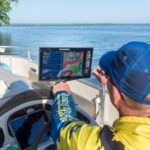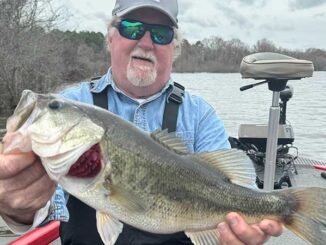
If you have the latest electronics onboard, you can forget Toledo Bend’s over-fished brush piles — and still find plenty of unpressured crappie.
Jerry “J.T.” Thompson stared intently at the screen of his 12-inch down-scan unit as he brought the pontoon boat off plane.
I leaned over, again struck by the amount of bottom detail seen on these electronics.
And then Thompson chuckled.
“Look at all the fish,” he said, pointing at a group of white dots arrayed on the edge of a drop in the bottom contour.
“Man, that’s great to see,” he said.
On the mid-April trip, I had expected to spend my two days with Living the Dream Guide Service bouncing from one Toledo Bend brush pile to another.
But when I stepped onto the boat, Thompson said he and his fellow LTD guides had discovered a new way to catch the slabs for which the huge reservoir is known.
“Something new we’ve been doing is catching fish on structure,” Thompson said. “The fish just aren’t on the brush piles yet, so we’ve been going out and finding structure holding fish.”
As an old bass angler, I loved that idea.
Now, it’s probable that, by June, brush piles throughout Toledo Bend will be teeming with crappie. So that’s still an option.
But the world of down- and side-scan electronics opens new possibilities to find sac-a-lait that haven’t been pounded to death.
“These fish are unpressured,” Thompson said. “The brush piles get hit constantly, but these fish don’t see baits.”
And catching these crappie is also a lot easier than when targeting brush piles.
“A fish that is located on a small piece of structure like a stump is much easier to catch than one stuck in a brush pile,” Thompson said. “If he’s out there on that stump, he’ll eat every time.”
Thompson uses a pair of Humminbird Solix 12s, with the screens split between a LakeMaster contour map, a down-scan image and a side-scan image.
The console unit allows him to use a contour map to navigate to likely contour breaks — those that drop sharply — and, with his down-scan, quickly determine if there’s anything worth probing.
When he heads to the trolling motor, his second unit provides the ability to stay on the fish.
What he wants to see on the down-scan imagery is some kind of cover on the bottom: a stump or tree, for example.
“You can see the structure that’s down there, and then you can see if there’s fish on it,” Thompson said.
While he does use side-scan imagery to locate potential hotspots off the sides of his boat, his down-scan images are the real key to spotting crappie.
“It’s harder to see fish on side-scan,” the guide explained. “You can see bass because you see the shadows of the fish, but crappie are harder to see.”
“Seeing” the fish on down-scan images is something of an art, since the units show baitfish as well as predators.
The key is the size and shape of the signature.
Baitfish, for instance, look more like static. And the little fish are usually in clumps.
Crappie show up as sort of round puffs.
“Once you train yourself what to look for, they’re easy to pick out because they look like little cheese balls,” Thompson said. “Crappie are easy to pick off of structure because they look like little cheese balls — they’re just little round disks.”
And, while it’s cool to idle over a spot and see dozens of fish ganged up, Thompson said he doesn’t hesitate to stop if only a few crappie show up.
“You don’t have to have a whole bunch of them on there to catch a whole bunch of fish because the shallower you go, they’re going to run from you,” he said.
So when he spots a few fish on some structure, he’ll shut off the main motor and spend a few minutes probing the area to allow any fish that were spooked to return.
Even if he doesn’t find the mother lode, such stops can quickly add to the box.
“You’ll wind up catching four or five fish, and you might crank up and motor not even a quarter of a mile and find four or five more and catch those, or at least, in general, you’re going to catch half of them,” Thompson said.
Because of the wary nature of crappie, the guide doesn’t look for shallow-water areas.
“I don’t usually try to look for fish in anything less than about 15 feet of water because it scatters them too bad,” Thompson said.
A color sonar unit also is mounted on the front of his boat so he can get a really good visual of what the fish are doing.
“You see those arches?” Thompson said, pointing to the screen. “Those are crappie.”
Above a group of these arches was a bunch of dots representing bait.
“You can watch the fish feed,” Thompson said. “When the baitfish ball curves up, they’re running from crappie.
“That’s when you know you’re on feeding fish.”
Thompson said he carefully manages his time to ensure he goes home with plenty of meat.
“When you come across some fish, fish for them,” he said. “Catch four or five, and if it slows down go find you some more — catch what you can.
“Don’t camp out on them, though.”
Get the depth right
Effective depths to target crappie vary, Living the Dream Guide Services’ Jerry “J.T.” Thompson said.
“Right now (in mid-April), we’re catching most of our fish in 15 to 18 feet of water,” Thompson said. “In June, that level may be 20 to 24 feet.”
But it also depends on the portion of the lake in which you’re fishing.
“Up and down the lake, that depth will change a little,” Thompson said. “Up north, there’s not as much depth, so the fish will be shallower. Down south they will be deeper.
“We know the fish in the San Patricio area will orient shallower than at Indian Mounds because there’s not as much depth.”
Just be certain you’re staying above the thermocline.
“There are no fish below the thermocline,” Thompson said. “There’s no oxygen down there.”
Again, you can expect the thermocline to be shallower in the northern reaches of the lake than down near the dam.
Get the best electronics
Jerry “J.T.” Thompson said he might skimp on some things, but electronics are worth a little splurge.
That’s why he has two Humminbird Solix 12s, which retail for nearly $3,000 each — but he said it’s money well spent.
“I’m not sponsored by any (manufacturer), but this is the only unit I’ll use,” Thompson said.
Of course, the amazing detail of the down- and side-scan imagery is one of the reasons he loves the unit.
But he said there’s also another important reason — particularly for anglers fishing on Toledo Bend.
“You can get Humminbird’s LakeMaster charts, and it’s the best contour mapping available,” Thompson said.
The charts, which were completed recently, show the lake’s bottom in 1-foot contours, allowing Thompson to precisely determine where he thinks crappie are most likely to congregate.
And the maps are available on an app, so he can pull them up on his iPad at home and make plans before he even hits the water.
The most important factor in getting the most out of your unit is to ensure the transducer is correctly mounted.
“The placement of your transducer is huge,” Thompson said. “I (originally) had mine mounted where it was hitting the lower unit (of the outboard), and it was messing up my picture. I moved it, and it made all the difference.
“I recommend putting it as far away from your motor as possible. Your picture will come out so much better.”
Paying someone who knows how the units operate is wise, he said.
“I recommend having it professionally installed,” Thompson said. “They will know what they’re doing.”
The key, whether you go all-in for a Solix or buy another of the many options, is to install electronics that will maximize your time on the water.
“You want to get the best electronics you can afford,” Thompson said. “It’s like what we do with all our hobbies and toys: You’ve got to spend as much money as you can to get the best electronics you can.
“You’re going to get what you pay for.”
Don’t forget the bridge
If you’re having trouble finding crappie on bottom contours, that’s OK. There’s another feature on Toledo Bend guaranteed to hold plenty of fish.
Just launch near Pendleton Bridge and ease into position under the roadway.
“The bridge always holds fish,” Thompson said. “We catch (crappie) on it summer, winter, whatever.
“It’s just an easy place to get started.”
He said the ends closest to the banks are usually crowded with boats early in the year because fish funnel through the pilings.
As the weather warms, however, fish move out to deeper water.
“The bridge is good, whether it’s day or night,” Thompson said. “The bridge has lights on it, so if it’s too hot to fish in the daytime, you can do it at night.”
He said fish tuck under the bridge during broiling summer days to take advantage of the shade.
“In the daytime you want to wait until the middle of the day, and then you can sit in that shade and fish,” he said.
No matter what time of day you hit the bridge, fishing is pretty consistent.
“Usually, about halfway to the bottom is where most of the fish are,” Thompson said. “They tend to come around those cross members that are there at about 12 feet.”
J.T.’s crappie rigs
Thompson loathes using live bait (although he carries minnows when he’s fishing with clients). Instead, he tightlines 1/32-ounce jigheads with plastics to pick up bites.
“I’m going to use a jig if I can catch one on it,” he said. “The only way I’m going to use a minnow is if I just can’t catch (a crappie) on a jig.”
But his rig is a bit different. Namely, he adds a 3/0 splitshot weight a few inches above the jig.
“I learned that from a guy named Bill Fondren,” Thompson said. “He said it gives (the jig) a little extra action; it makes that jig do something different.
“And he said that crappie have to be able to see that splitshot, so it looks like a little fish chasing something.”
Of course, the added weight also makes it easier to cast when the wind is blowing.
The only downside to fishing jigs on structure is that you can count on getting hung up.
“If you’re going to structure fish, you have to have a lot of jigheads,” Thompson said. “You will get hung up and you will break off.”
He uses a variety of plastics, including Bobby Garland Baby Shads, Cajun Lures Slim Jimmys and Panfish Assassins.
Color is determined based on time of day, although for this crappie slayer it’s more a matter of shade.
“Earlier in the day I’ll use something a little darker; something with more contrast to it,” Thompson said. “The brighter the day, the lighter the color. You don’t need as much contrast.”
And crappie niblets are usually found on his jigs.
“I hate the fact that I need them because it goes against everything we say — you want (your jig) to look natural, and then you put a piece of butt cheese on it,” Thompson said. “But the stuff works. It just works.”
He uses fluorocarbon line because it gets more bites, with 8-pound his choice when guiding and 6-pound being used when he’s out fishing for fun.
“I’m going to get bit more,” Thompson said. “But fluorocarbon is expensive, and you’re going to go through a bunch of it.
“You’re going to break off.”








